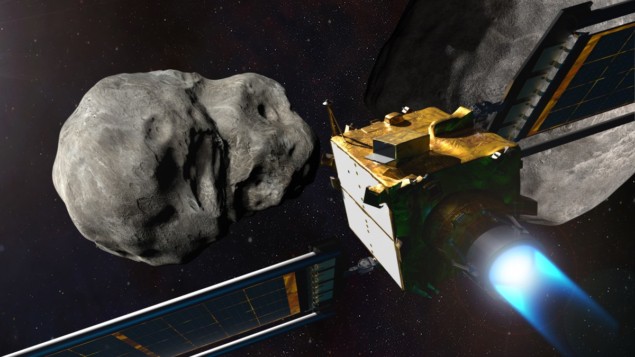The Physics World 2022 Breakthrough of the Year goes to NASA and a team led by the Johns Hopkins Applied Physics Laboratory in the US for the first demonstration of “kinetic impact” by successfully changing the orbit of an asteroid. This was done using the Double Asteroid Redirection Test (DART) spacecraft, which was launched in November 2021 and impacted its target asteroid in September 2022.

To Bo Zhao, Jian-Wei Pan and colleagues at the University of Science and Technology of China (USTC) and the Chinese Academy of Sciences in Beijing; and independently to John Doyle and colleagues at Harvard University in the US, for creating the first ultracold polyatomic molecules.
Although physicists have been cooling atoms to a fraction above absolute zero for more than 30 years, and the first ultracold diatomic molecules appeared in the mid-2000s, the goal of making ultracold molecules containing three or more atoms had proved elusive.
Using different and complementary techniques, the USTC and Harvard teams produced samples of triatomic sodium-potassium molecules at 220 nK and sodium hydroxide at 110 µK, respectively. Their achievement paves the way for new research in both physics and chemistry, with studies of ultracold chemical reactions, novel forms of quantum simulation, and tests of fundamental science all closer to being realized thanks to these multi-atom molecular platforms.
- Read more: “Ultracold triatomic molecules herald a new frontier for the three-body problem” and “Laser cooling of polyatomic molecules brings ultracold chemistry into the spotlight“
Observing the tetraneutron
To Meytal Duer at the Institute for Nuclear Physics at Germany’s Technical University of Darmstadt and the rest of the SAMURAI Collaboration for observing the tetraneutron and showing that uncharged nuclear matter exists, if only for a very short time.
Comprising four neutrons, the tetraneutron was spotted at the RIKEN Nishina Centre’s Radioactive Ion Beam Factory in Japan. The tetraneutrons were created by firing helium-8 nuclei at a target of liquid hydrogen. The collisions can split a helium-8 nucleus into an alpha particle (two protons and two neutrons) and a tetraneutron.
By detecting the recoiling alpha particles and hydrogen nuclei, the team worked out that the four neutrons existed in an unbound tetraneutron state for just 10−22 s. The statistical significance of the observation is greater than 5σ, putting it over the threshold for a discovery in particle physics. The team now plans to study the individual neutrons within tetraneutrons and look for new particles containing six and eight neutrons.
- Read more: “Elusive tetraneutron is discovered at Japanese lab“
Super-efficient electricity generation
To Alina LaPotin, Asegun Henry and colleagues at the Massachusetts Institute of Technology and the National Renewable Energy Laboratory, US, for constructing a thermophotovoltaic (TPV) cell with an efficiency of more than 40%.
The new TPV cell is the first solid-state heat engine of any kind to convert infrared light into electrical energy more efficiently than a turbine-based generator, and it can operate with a broad range of possible heat sources. These include thermal energy storage systems, solar radiation (via an intermediate radiation absorber) and waste heat as well as nuclear reactions or combustion. The device could therefore become an important component of a cleaner, greener electricity grid, and a complement to visible-light solar photovoltaic cells.
- Read more: “Thermophotovoltaic cells top 40 per cent efficiency“
The fastest possible optoelectronic switch
To Marcus Ossiander, Martin Schultze and colleagues at the Max Planck Institute for Quantum Optics and LMU Munich in Germany; the Vienna University of Technology and the Graz University of Technology in Austria; and the CNR NANOTEC Institute of Nanotechnology in Italy, for defining and exploring the “speed limits” of optoelectronic switching in a physical device.
The team used laser pulses lasting just one femtosecond (10−15 s) to switch a sample of a dielectric material from an insulating to a conducting state at the speed needed to realize a switch that operates 1000 trillion times a second (one petahertz). Although the apartment-sized apparatus required to drive this super-fast switch means it will not appear in practical devices any time soon, the results imply a fundamental limit for classical signal processing and suggest that petahertz solid-state optoelectronics is, in principle, feasible.








 User Center
User Center My Training Class
My Training Class Feedback
Feedback












Comments
Something to say?
Log in or Sign up for free